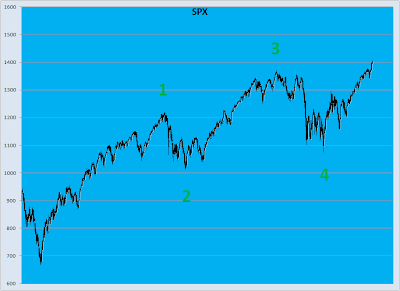Yesterday we said we expected a sell-off on Tuesday, and we didn’t have to wait long for it to materialize, the SPX hitting the day’s low of 1397.68 within the first half hour of trading. From there the index
tried to claw its way back up to the close. From its lows, it first bounced back to 1402.52, completing Wave 1 of a corrective wave. An inverted Wave 2 was next, taking the market to 1403.92, before finishing at 1400.97. Wave 3 brought the market back to 1405.35, before giving some of it back during Wave 4, dropping to 1403.6. From there the rally continued almost to the close, bringing the market up to 1407.23. At that point our criteria for a 5 wave sequence from the 1397.68 low were met. The SPX then dipped once again in the last half hour, hitting a low of 1404.06, before closing the day at 1405.52.
tried to claw its way back up to the close. From its lows, it first bounced back to 1402.52, completing Wave 1 of a corrective wave. An inverted Wave 2 was next, taking the market to 1403.92, before finishing at 1400.97. Wave 3 brought the market back to 1405.35, before giving some of it back during Wave 4, dropping to 1403.6. From there the rally continued almost to the close, bringing the market up to 1407.23. At that point our criteria for a 5 wave sequence from the 1397.68 low were met. The SPX then dipped once again in the last half hour, hitting a low of 1404.06, before closing the day at 1405.52.
It would seem that today the market completed Waves 3, and 4 of a 5 wave sequence from the 1414 high. We would project a low for this sequence at about 1393. If the market moves above 1407.23, we would need to complete another 5 wave sequence to the upside, before continuing onto Wave 5. A move above 1410 before reaching our downside target would mean 1397.68 was the low of a 5 wave sequence from 1414 that we were unable to discern. The move from that low would then be a wave 2.
1414 is still the level at which we believe a major top was put in place. If we break through that level we will have to watch the 1421 level, the upper bound of our target range for the 666 low. That would most likely mean the previous high of 1378(which was within our target range), was the actual Wave 5 top, and we have begun an inverted wave 2. For now we still feel comfortable with our current take on the market.










